Click on any picture below for an 'uncropped' view.
Wolverhampton Station
Almost all my trips by rail start from Wolverhampton. I've always found the 'new' station building erected during electrification particularly dismal, so I've only just been persuaded to take a picture of the view which greets the passenger from the station approach road. All my Railway pictures around Wolverhampton station and in the West Midlands are here.
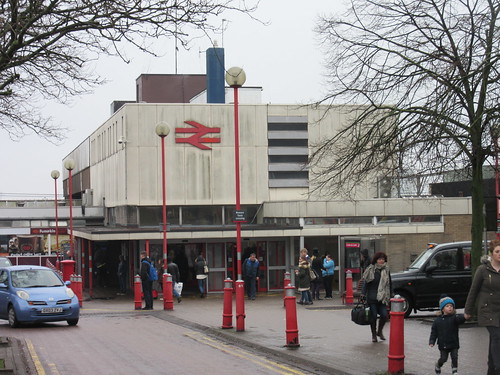 Wolverhampton Station.
Wolverhampton Station.
The depression that the sight of this uninspired building invokes is usually quickly compounded by a sense of being 'fleeced' when purchasing a ticket (although nowadays I sometimes buy tickets on the internet in advance). On both of my recent trips, I was travelling on the 06:04 departure to Euston and on each day Virgin did get me to Euston within a few minutes of right time.
Events of 14th January 2016
On the first of these trips, when I arrived at Euston I decided to take a Victoria Line train to Victoria. This proved to be a mistake as a signalling failure south of Victoria meant that southbound trains were only going as far as Victoria before reversing. Because of this, we were held for a few minutes at both Oxford Circus and Green Park to allow earlier trains to sort themselves out.
At Victoria, I lost no time in heading for the Brighton Line platforms and was on the move quite quickly to East Croydon with just one intermediate stop at Clapham Junction.
I knew that I had to change at East Croydon but, in theory at least, I might still have been earlier into my destination, Coulsdon South, than by travelling via London Bridge. However, the time lost on the Victoria Line ensured that this was not the case.
When my meeting was over, I walked back to Coulsdon South Station and, whilst waiting for my train back to London, I conducted a quick photographic survey. Of the 'bus shelters' on both platforms, the less said, the better. But the inoffensive brick station building on the Up side had been quite nicely renovated and the ticket office was staffed so, overall, I was quite impressed.
 Coulsdon South Station.
Coulsdon South Station.
One odd feature of the location of Coulsdon South station is the parallel Brighton main line a little over 100 yards away on which frequent fast trains (including the 'Gatwick Express' service) pass in both directions. This results from the rather curious origins of the history of these lines, outlined in Early railways around London below. The South Eastern Railway ended up sharing the London and Brighton metals to Stoats Nest (about one mile south of Purley station) then continuing on its own route through what is now Coulsdon South to Redhill.
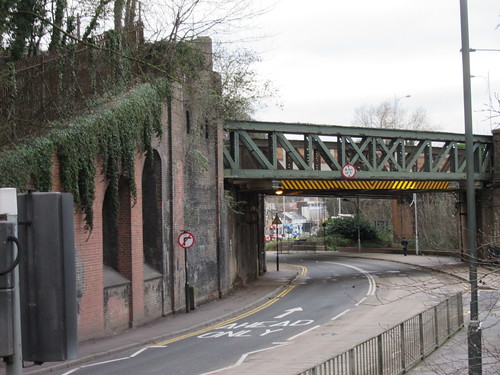 Bridge carrying the Brighton main line viewed from the road approach to Coulsdon South Station.
Bridge carrying the Brighton main line viewed from the road approach to Coulsdon South Station.
My train (a Bombardier 'Electrostar' Class 377) arrived on time and we made uneventful progress back to the still-being-rebuilt London Bridge, arriving at terminal platform 11.
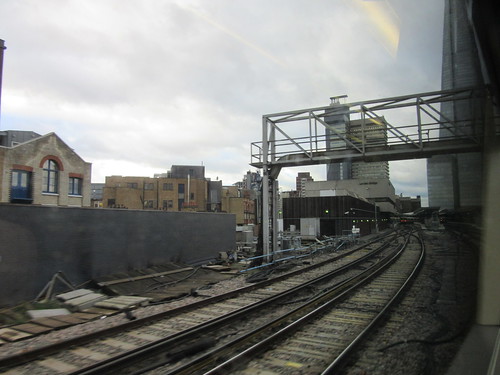 The rebuilt terminal platforms at London Bridge viewed from my arriving train.
The rebuilt terminal platforms at London Bridge viewed from my arriving train.
I wrote about the rebuilding of London Bridge in August 2015 in the post Visiting former 'Southern' stations in London and there's a suitably upbeat article from Network Rail about the project here.
The arched roof flanked by glazed bays which stood over the terminal platforms for more than a century has, of course, gone. Each rebuilt platform now has umbrella roofing supported on substantial, fabricated rectangular pillars. For some reason, the roof itself is wavy. It's probably not necessary to comment that it didn't appeal to me.
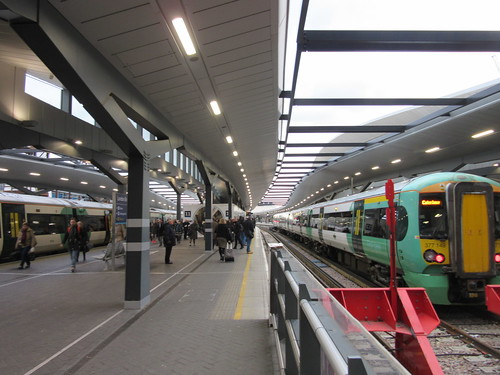 'Wavy' umbrella roofing on the terminal platforms at London Bridge.
'Wavy' umbrella roofing on the terminal platforms at London Bridge.
However, the airy, light concourse area is a distinct improvement on the muddle of the former arrangements. But development is not scheduled to be completed until 2018 so intrusive 'retail opportunities' may yet damage the effect. Network Rail excitedly refer to "the huge concourse, natural light ... bigger than the pitch at Wembley Stadium".
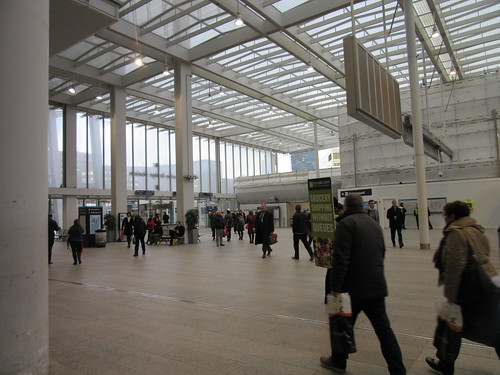 The new concourse at London Bridge.
The new concourse at London Bridge.
It's quite a walk to the Underground station and, on the way, 'London Bridge Vaults' already presents a host of 'retail opportunities'. The Northern Line then conveyed me back to Euston to catch a 'Virgin' service back to Wolverhampton.
Events of 28th January 2016
This time, on arrival at Euston, I took a Northern Line (City Branch) train to London Bridge which allowed me to join the 08:30 Horsham service and arrive at Coulsdon South just after 09:00 - a better result than on the 14th January.
When my meeting was finished, I caught the first train back to London. This was a 'Thameslink' service to Bedford, booked to call at East Croydon and Blackfriars, omitting London Bridge because of the continuing remodelling there. After the East Croydon stop, we sped past the massive Selhurst Depot.
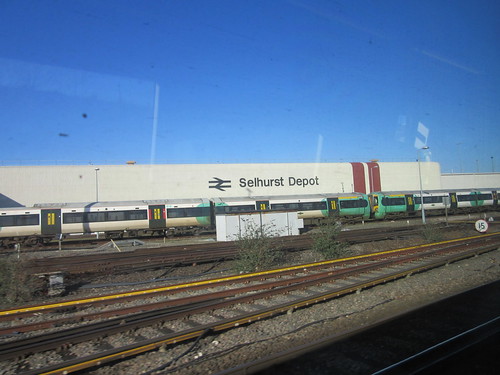 Selhurst Depot viewed from the Up London Bridge Fast.
Selhurst Depot viewed from the Up London Bridge Fast.
We passed through Norwood Junction and turned left onto the Up Crystal Palace Spur. At this point signalling control changed from Three Bridges Area Signalling Centre to Victoria Area Signalling Centre. The train continued through Crystal Palace, Gipsy Hill and West Norwood at a very sedate pace.
I realised that we were traversing the route I'd taken in the opposite direction on 12th February 2014. This trip was described in the post Industrial Action. On that occasion, I'd used the 'Thameslink' service because the 'Tube' was on strike but my train was diverted away from London Bridge because of a 'Signalling Failure'.
After West Norwood station, we took the Up West Norwood Spur, to reach Tulse Hill South Junction.
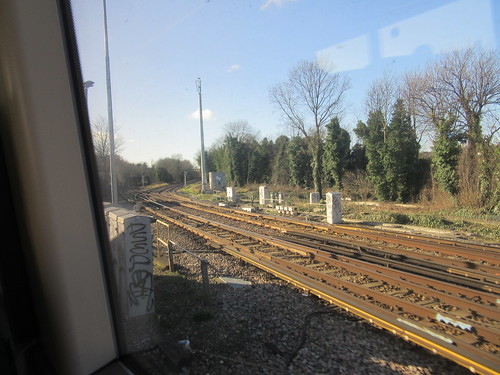 Tulse Hill South Junction, viewed from a train on the Up West Norwood Spur. The Portsmouth lines are in the centre, with the Leigham Spurs (leading to Balham) curving away to the right.
Tulse Hill South Junction, viewed from a train on the Up West Norwood Spur. The Portsmouth lines are in the centre, with the Leigham Spurs (leading to Balham) curving away to the right.
Having passed through Tulse Hill station, we continued our leisurely progress and turned left onto the Up Holborn line leading to Herne Hill. On my right, I was too slow to catch a picture of the splendid south portal of Knight's Hill Tunnel, but there's a little piece on the 'Southern E-Group' site here and a decent picture on 'Geograph' here.
At Herne Hill, the Chatham Lines joined on our right and, after the station, diverged on our left. Another mile took us to Loughborough Junction where the Brixton Spurs joined on the left, the Cambria Spurs joined on the right and we became four track through Elephant and Castle (Up and Down Holborn Slow, Up and Down Holborn Fast).
When we stopped at London Blackfriars, I was surprised when the driver shut-down the cab and restarted it. I wondered if some of the earlier slow running was related to a problem he was trying to clear. The re-built Blackfriars still offers views along the river. I was struck, once again, by just how ugly the re-development of Charing Cross station is (and it's up against some pretty stiff competition in London). At least the road side of the station and the concourse retains some dignity (see my picture album London Charing Cross Station).
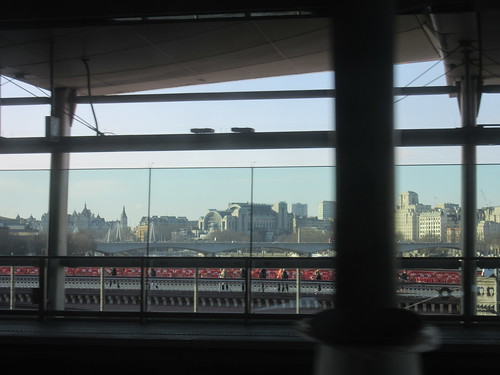 View from London Blackfriars station, looking upriver, with Charing Cross station in the centre.
View from London Blackfriars station, looking upriver, with Charing Cross station in the centre.
The train continued to the gloom of City Thameslink. After a brief pause, we carried on to Farringdon, passing the brightly-lit Smithfield Sidings on our left before entering the platform where the driver switched the dual-voltage train to receive a.c. current from the pantograph for the remainder of the journey. Our next stop was St. Pancras International, where I left the train. I'd not noticed before that the Overhead Line Equipment through the low-level platform features a solid aluminium extruded beam, rather than the usual Contact wire.
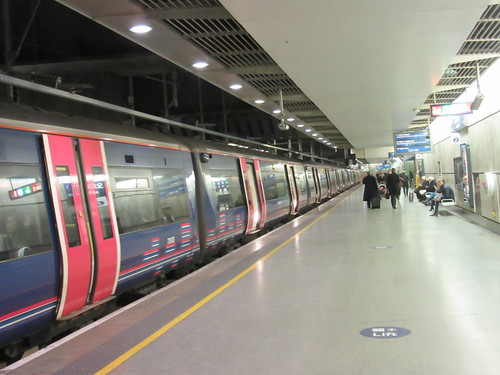 St. Pancras International.
St. Pancras International.
I walked to Euston and was able to catch a 'Pendolino' to Preston via Wolverhampton. I tend to travel in the 'Quiet Coach' which usually means walking the length of the train at Euston as Coach 'A' is normally at the 'country end'. I'm happy to report that, once again, we made a right-time arrival in Wolverhampton.
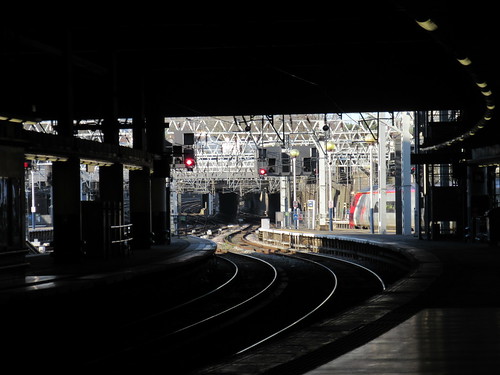 Euston: View from platform 7 looking towards Camden bank.
Euston: View from platform 7 looking towards Camden bank.
Early railways around London
The London & Greenwich Railway was opened throughout by 1838 with its London terminus at Tooley Street (now London Bridge). The following year, the London & Croydon Railway opened from West Croydon to a junction with the London & Greenwich Railway, sharing the Tooley Street terminus. In turn, the London & Brighton Railway opened throughout in 1841 from Brighton to a junction with the London and Croydon Railway, then sharing their lines to Tooley Street. The South Eastern Railway had obtained parliamentary approval for a line from London to Dover in 1836 but this railway was also to share the lines of the London & Greenwich Railway, the London and Croydon Railway and the London & Brighton Railway as far as Purley. Furthermore, the London & Brighton Railway was to build, at cost, the line on behalf of the South Eastern Railway from its junction with the London & Brighton Railway to Redhill. This line stayed quite close to the London and Brighton line and crossed under it to reach Redhill! After this rather tedious route out of London, William Cubitt then provided the South Eastern Railway with an almost dead straight main line from Redhill to Folkestone and Dover, with major intermediate stations provided with through lines for fast trains and platform loops for stopping trains.

Click on the map for a larger view.
1905 Railway Clearing House Map of lines in the vicinity of Coulsdon.
My pictures
These albums include pictures from these and earlier trips.
West Midland Railways.
London & Birmingham Railway.
London: former 'Southern' lines.
